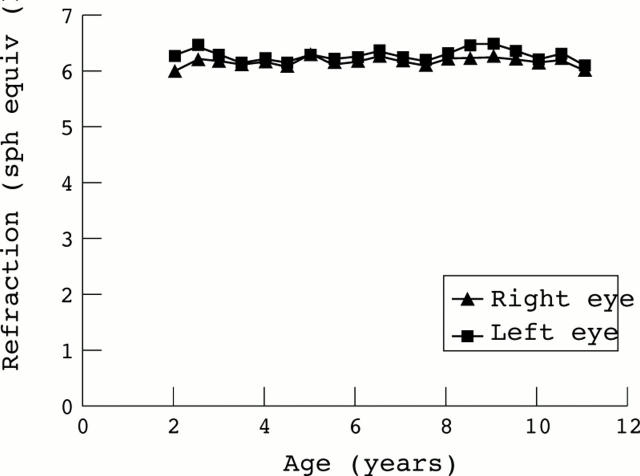Abstract
AIM—To examine outcome among children with refractive accommodative esotropia. METHODS—Children with accommodative esotropia associated with hyperopia were included in the study. The features studied were ocular alignment, amblyopia, and the response to treatment, binocular single vision, requirement for surgery, and the change in refraction with age. RESULTS—103 children with refractive accommodative esotropia were identified. Mean follow up was 4.5 years (range 2-9.5 years). 41 children (39.8%) were fully accommodative (no manifest deviation with full hyperopic correction). The remaining 62 children (60.2%) were partially accommodative. At presentation 61.2% of children were amblyopic in one eye decreasing to 15.5% at the most recent examination. Stereopsis was demonstrated in 89.3% of children at the most recent examination. Mean cycloplegic refraction (dioptres, spherical equivalent) remained stable throughout the follow up period. The mean change in refraction per year was 0.005 dioptres (D) in right eyes (95% CL −0.0098 to 0.02) and 0.001 D in left eyes (95% CL −0.018 to 0.021). No patients were able to discard their glasses and maintain alignment. CONCLUSIONS—Most children with refractive accommodative esotropia have an excellent outcome in terms of visual acuity and binocular single vision. Current management strategies for this condition result in a marked reduction in the prevalence of amblyopia compared with the prevalence at presentation. The degree of hyperopia, however, remains unchanged with poor prospects for discontinuing glasses wear. The possibility that long term full time glasses wear impedes emmetropisation must be considered. It is also conceivable, however, that these children may behave differently with normal and be predestined to remain hyperopic.
Full Text
The Full Text of this article is available as a PDF (108.9 KB).
Figure 1 .
Graph showing the mean refraction (dioptres, spherical equivalent) of right and left eyes versus age (years). Mean refraction remains stable throughout the follow up period.
Figure 2 .
Histogram of the mean change in refraction per year. This demonstrates that most eyes show little or no change in refraction.
Selected References
These references are in PubMed. This may not be the complete list of references from this article.
- Abrahamsson M., Fabian G., Sjöstrand J. Refraction changes in children developing convergent or divergent strabismus. Br J Ophthalmol. 1992 Dec;76(12):723–727. doi: 10.1136/bjo.76.12.723. [DOI] [PMC free article] [PubMed] [Google Scholar]
- Atkinson J., Braddick O., Robier B., Anker S., Ehrlich D., King J., Watson P., Moore A. Two infant vision screening programmes: prediction and prevention of strabismus and amblyopia from photo- and videorefractive screening. Eye (Lond) 1996;10(Pt 2):189–198. doi: 10.1038/eye.1996.46. [DOI] [PubMed] [Google Scholar]
- Au Eong K. G., Tay T. H., Lim M. K. Education and myopia in 110,236 young Singaporean males. Singapore Med J. 1993 Dec;34(6):489–492. [PubMed] [Google Scholar]
- Baker J. D., Parks M. M. Early-onset accommodative esotropia. Am J Ophthalmol. 1980 Jul;90(1):11–18. doi: 10.1016/s0002-9394(14)75070-6. [DOI] [PubMed] [Google Scholar]
- Fielder A. R., Moseley M. J. Does stereopsis matter in humans? Eye (Lond) 1996;10(Pt 2):233–238. doi: 10.1038/eye.1996.51. [DOI] [PubMed] [Google Scholar]
- Flitcroft D. I. A model of the contribution of oculomotor and optical factors to emmetropization and myopia. Vision Res. 1998 Oct;38(19):2869–2879. doi: 10.1016/s0042-6989(98)00087-x. [DOI] [PubMed] [Google Scholar]
- Gobin M. La vision binoculaire après correction chirurgicale du strabisme accommodatif. Bull Mem Soc Fr Ophtalmol. 1985;96:95–97. [PubMed] [Google Scholar]
- Hoyt C. S., Stone R. D., Fromer C., Billson F. A. Monocular axial myopia associated with neonatal eyelid closure in human infants. Am J Ophthalmol. 1981 Feb;91(2):197–200. doi: 10.1016/0002-9394(81)90173-2. [DOI] [PubMed] [Google Scholar]
- Hung L. F., Crawford M. L., Smith E. L. Spectacle lenses alter eye growth and the refractive status of young monkeys. Nat Med. 1995 Aug;1(8):761–765. doi: 10.1038/nm0895-761. [DOI] [PubMed] [Google Scholar]
- Ingram R. M., Arnold P. E., Dally S., Lucas J. Emmetropisation, squint, and reduced visual acuity after treatment. Br J Ophthalmol. 1991 Jul;75(7):414–416. doi: 10.1136/bjo.75.7.414. [DOI] [PMC free article] [PubMed] [Google Scholar]
- Ingram R. M., Gill L. E., Goldacre M. J. Emmetropisation and accommodation in hypermetropic children before they show signs of squint--a preliminary analysis. Bull Soc Belge Ophtalmol. 1994;253:41–56. [PubMed] [Google Scholar]
- Jampolsky A., von Noorden G. K., Spiritus M. Unnecessary surgery in fully refractive accommodative esotropia. Int Ophthalmol. 1992 Mar;16(2):129–131. doi: 10.1007/BF00918947. [DOI] [PubMed] [Google Scholar]
- Morgan R. W., Speakman J. S., Grimshaw S. E. Inuit myopia: an environmentally induced "epidemic"? Can Med Assoc J. 1975 Mar 8;112(5):575–577. [PMC free article] [PubMed] [Google Scholar]
- Mäntyjärvi M. I. Changes of refraction in schoolchildren. Arch Ophthalmol. 1985 Jun;103(6):790–792. doi: 10.1001/archopht.1985.01050060050022. [DOI] [PubMed] [Google Scholar]
- Paris V., Andris C., Moutschen A. Bienfaits de la correction hypermétropique totale chez les patients strabiques. Bull Soc Belge Ophtalmol. 1995;259:143–153. [PubMed] [Google Scholar]
- Tay M. T., Au Eong K. G., Ng C. Y., Lim M. K. Myopia and educational attainment in 421,116 young Singaporean males. Ann Acad Med Singapore. 1992 Nov;21(6):785–791. [PubMed] [Google Scholar]
- Wick B. Accommodative esotropia: efficacy of therapy. J Am Optom Assoc. 1987 Jul;58(7):562–566. [PubMed] [Google Scholar]
- Wiesel T. N., Raviola E. Myopia and eye enlargement after neonatal lid fusion in monkeys. Nature. 1977 Mar 3;266(5597):66–68. doi: 10.1038/266066a0. [DOI] [PubMed] [Google Scholar]
- Wilson M. E., Bluestein E. C., Parks M. M. Binocularity in accommodative esotropia. J Pediatr Ophthalmol Strabismus. 1993 Jul-Aug;30(4):233–236. doi: 10.3928/0191-3913-19930701-04. [DOI] [PubMed] [Google Scholar]
- Zylbermann R., Landau D., Berson D. The influence of study habits on myopia in Jewish teenagers. J Pediatr Ophthalmol Strabismus. 1993 Sep-Oct;30(5):319–322. doi: 10.3928/0191-3913-19930901-12. [DOI] [PubMed] [Google Scholar]
- von Noorden G. K., Avilla C. W. Refractive accommodative esotropia: a surgical problem? Int Ophthalmol. 1992 Jan;16(1):45–48. doi: 10.1007/BF00917072. [DOI] [PubMed] [Google Scholar]




